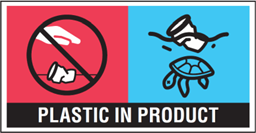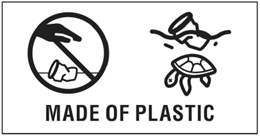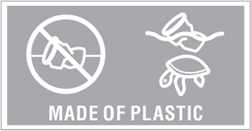ANNEX IVU.K. Harmonised marking specifications for beverage cups
1.Beverage cups made partly from plastic shall bear the following printed marking:U.K.
:
the black line bordering the marking is not part thereof. Its only purpose is to show the thin white line bordering the marking against the white page.
By way of derogation from the first sentence of this point, the marking of beverage cups made partly from plastic placed on the market before 4 July 2022 may be affixed by means of stickers.
2.Beverage cups made wholly from plastic shall bear either the following printed marking or the following engraved/embossed marking:U.K.
:
the black line bordering the marking is not part thereof. Its only purpose is to provide contrast against the white page.
By way of derogation from the first sentence of this point, the marking of beverage cups made wholly from plastic placed on the market before 4 July 2022 may be affixed by means of stickers.
:
the black line bordering the marking and grey background are not part thereof. Its only purpose is to provide contrast against the white page.
3.The marking for beverage cups made partly from plastic shall comply with the requirements laid down in this point.U.K.
Position of the marking
Traditional cups:
The marking shall be placed horizontally on the external surface of the cup away from the rim to avoid contact with the consumer’s mouth when drinking. The marking shall not be placed under the base of the cup.
Champagne-type cups:
The marking shall be placed horizontally on the external surface of the cup, including the upper side of the base that holds the stem. The marking shall be placed away from the rim to avoid contact with the consumer’s mouth when drinking. The marking shall not be placed under the base of the cup.
Where it is not possible to place the marking horizontally due to the shape or size of the cup, it may be rotated 90° and placed vertically.
The boxes of the marking shall not be separated.
Size of the marking
The marking shall be composed of two equal-sized red and blue boxes, which are placed next to each other, and a rectangular black box containing the information text ‘PLASTIC IN PRODUCT’ placed below the two equal-sized boxes. The ratio between the height and length of the marking shall be 1:2.
For cups with a volume of less than 500 ml, the minimum size of the marking shall be 1,4 cm by 2,8 cm (3,92 cm2).
For cups with a volume of 500 ml or more, the minimum size of the marking shall be 1,6 cm by 3,2 cm (5,12 cm2).
Design of the marking
The design of the marking shall be reproduced without adding any effects, adjusting the colours, retouching or extending the background. The marking shall be reproduced at a minimum resolution of 300 dots per inch when printed in actual size. The marking shall be bordered by a thin white line.
The information text ‘PLASTIC IN PRODUCT’ shall be in upper case and in Helvetica Bold font. The font size shall be a minimum of 5 pt for the cups of less than 500 ml and of 6 pt for the cups of 500 ml or more.
Where the information text is translated into another or several official languages of the Member States, the translated information text shall be placed either close below the marking, or inside the rectangular black box below the first language, and shall be in both cases clearly visible. In exceptional cases due to spatial constraints on the external surface of the cup, the information text translated into another or several official languages of the Member States may be placed elsewhere on the cup as close as possible to the marking and where it is clearly visible. The translated information text shall be in upper case and in Helvetica Bold font. The font size shall be a minimum of 5 pt for the cups of less than 500 ml and 6 pt for the cups of 500 ml and more. Where the information text in additional languages is placed in the rectangular black box, derogations from the maximum required size of the marking are possible.
The colours having the following colour codes shall be used:
White: C = 0 / M = 0 / Y = 0 / K = 0
Black: C = 0 / M = 0 / Y = 0 / K = 100
Red: C = 0 / M = 90 / Y = 60 / K = 0
Blue: C = 60 / M = 0 / Y = 0 / K = 0.
4.The marking for beverage cups made wholly from plastic shall comply with the requirements laid down in this pointU.K.
Position of the marking
Traditional cups
The marking shall be placed horizontally on the external surface of the cup, wherever is more clearly visible. The marking shall not be placed under the base of the cup. When printed, the marking shall be placed away from the rim to avoid contact with the consumer’s mouth when drinking In the case of ridged cups, the marking shall not be embossed/engraved on the ridges.
Champagne-type cups
The marking shall be placed horizontally on the external surface of the cup, including the upper side of the base that holds the stem, wherever is more clearly visible. The marking shall not be placed under the base of the cup. When printed, the marking shall be placed away from the rim to avoid contact with the consumer’s mouth when drinking In the case of ridged cups, the marking shall not be embossed/engraved on the ridges.
Where it is not possible to place the marking horizontally due to the shape or size of the cup, it may be rotated 90° and placed vertically.
Size of the marking
The marking shall be rectangular-shaped and ratio between the height and length is 1:2.
For cups with a volume of less than 500 ml, the minimum size of the marking shall be 1,4 cm by 2,8 cm (3,92 cm2).
For cups with a volume of 500 ml or more, the minimum size of the marking shall be 1,6 cm by 3,2 cm (5,12 cm2).
Design of the marking
Printed:
The design of the marking shall be reproduced in black ink without adding any effects, retouching or extending the background. The marking shall be reproduced at a minimum resolution of 300 dots per inch when printed in actual size. The marking should have sufficiently high contrast to the background to be highly readable. To this end, the outline of the marking should be printed in one of the following colours.
White: C = 0 / M = 0 / Y = 0 / K = 0
Black: C = 0 / M = 0 / Y = 0 / K = 100
Red: C = 0 / M = 90 / Y = 60 / K = 0
Blue: C = 60 / M = 0 / Y = 0 / K = 0.
Engraved/embossed:
The design of the marking shall be reproduced without adding effects, retouching or extending the background. The white outline as shown in the marking under point 1.2 of this Annex represents the lines to be engraved or embossed on the cup.
The information text ‘MADE OF PLASTIC’ shall be in upper case and in Helvetica Bold font. The font size shall be a minimum of 5 pt for the cups of less than 500 ml and of 6 pt for the cups of 500 ml or more.
Where the information text is translated into another or several official languages of the Member States, the translated information text shall be placed either close below the marking, or inside the rectangular black box below the first language, and shall be in both cases clearly visible. In exceptional cases due to spatial constraints on the external surface of the cup, the information text translated into another or several official languages of the Member States may be placed elsewhere on the cup as close as possible to the marking and where it is clearly visible. The translated information text shall be in upper case and in Helvetica Bold font. The font size shall be a minimum of 5 pt for the cups of less than 500 ml and 6 pt for the cups of 500 ml and more.
When printed, the colours having the following colour codes shall be used:
White: C = 0 / M = 0 / Y = 0 / K = 0
Black: C = 0 / M = 0 / Y = 0 / K = 100.


